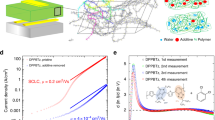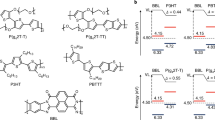Abstract
DIODES formed from semiconductor/metal interfaces often display non-ideal electronic properties. For instance, silicon/metal (Schottky) diodes made from n-type silicon and a variety of contacting metals exhibit only small differences in their rectification properties, despite theoretical and practical expectations that changes in the metal should effect changes in device properties1,2. Similarly, Schottky diodes formed on p-type silicon generally exhibit ohmic behaviour with poor rectification characteristics. This lack of electrical response to changes in the properties of the contacting metal phase is generally attributed to interfacial reactions that take place during the high-temperature thermal or electron-beam deposition of metals onto silicon3. Here we describe the fabrication of diodes using a low-temperature chemical procedure, in which contact to the semiconductor is made by a layer of the conducting organic polymer, polyacetylene. Unlike conventional metals, the electrical properties of polyacetylene can be manipulated through choice of the polymer dopant. The resultant organic/inorganic interfaces behave more ideally than contacts with conventional metals, in that changes in the electrical properties of the conducting polymer exert a large and predictable effect on the electrical properties of the resulting semiconductor/polymer diodes.
This is a preview of subscription content, access via your institution
Access options
Subscribe to this journal
Receive 51 print issues and online access
$199.00 per year
only $3.90 per issue
Buy this article
- Purchase on Springer Link
- Instant access to full article PDF
Prices may be subject to local taxes which are calculated during checkout
Similar content being viewed by others
References
Brillson, L. J. Surf. Sci. Rep., 2, 123–326 (1982).
Sze, S. M. Physics of Semiconductor Devices, 245–311 (Wiley, New York, 1981).
Bachrach, R. Z. in Metal-Semiconductor Schottky Barrier Junctions and Their Applications (ed. Sharma, B. L.) 93–99 (Plenum, New York, 1984).
Gronet, C. M., Lewis, N. S., Cogan, G. & Gibbons, J. Proc. natn. Acad. Sci. U.S.A. 80, 1152–1156 (1983).
Klavetter, F. L. & Grubbs, R. H. J. Am. chem. Soc. 110, 7807–7813 (1988).
Schaverien, C., Dewan, J. & Schrock, R. R. J. Am. chem. Soc. 108, 2771–2773 (1986).
Pekker, S. & Janossy, A. in Handbook of Conducting Polymers (ed. Skotheim, T. A.) 45–79 (Dekker, New York, 1986).
Pochan, J. M. in Handbook of Conducting Polymers (ed. Skotheim, T. A.) 1383–1405 (Dekker, New York, 1986).
Purtell, R. et al. J. Vac. Sci. Technol. 21, 615–616 (1982).
Franciosi, A. et al. J. Vac. Sci. Technol. 21, 624–627 (1982).
Grunthaner, P. J., Grunthaner, F. J. & Madhukar, A. J. J. Vac. Sci. Technol. 21, 637–638 (1982).
Salaneck, W. R. et al. J. chem. Phys. 72, 3674–3678 (1980).
Lee, J., Hanrahan, C., Arias, J., Martin, R. M. & Metiu, H. Phys. Rev. B32, 8216–8219 (1985).
Ozaki, M. et al. Appl. Phys. Lett. 35, 83–85 (1979).
Vannikov, A. V. & Zhuravleva, T. S. J. molec. Electron. 5, 63–70 (1989).
Kanicki, J. in Handbook of Conducting Polymers (ed. Skotheim, T. A.) 609–613 (Dekker, New York, 1986).
Simon, R. A. & Wrighton, M. S. Appl. Phys. Lett. 44, 930–932 (1984).
Burroughes, J. H., Jones, C. A. & Friend, R. H. Nature 335, 137–141 (1988).
Bottt, D. et al. Synth. Metals 14, 245–269 (1986).
Edwards, J., Feast, W. J. & Bott, D. Polymer 25, 395–398 (1984).
Author information
Authors and Affiliations
Rights and permissions
About this article
Cite this article
Sailor, M., Klavetter, F., Grubbs, R. et al. Electronic properties of junctions between silicon and organic conducting polymers. Nature 346, 155–157 (1990). https://doi.org/10.1038/346155a0
Received:
Accepted:
Issue Date:
DOI: https://doi.org/10.1038/346155a0
This article is cited by
-
Tunable electronic interfaces between bulk semiconductors and ligand-stabilized nanoparticle assemblies
Nature Materials (2007)
-
Interfaces behaving well
Nature Materials (2007)
-
Photophysical properties of polymers with a system of conjugated bonds and their use in light energy conversion processes
Theoretical and Experimental Chemistry (1995)
-
Investigation of the photoelectrophysical and spectral characteristics of the heterostructure of cadmium telluride ? An electrically conducting poly(N-epoxypropylcarbazole)
Theoretical and Experimental Chemistry (1994)
-
Research opportunities in polycrystalline compound solar cells
Journal of Electronic Materials (1993)
Comments
By submitting a comment you agree to abide by our Terms and Community Guidelines. If you find something abusive or that does not comply with our terms or guidelines please flag it as inappropriate.



